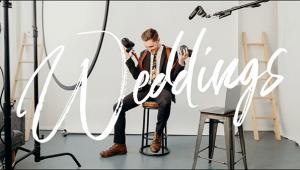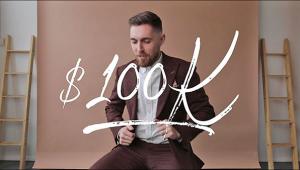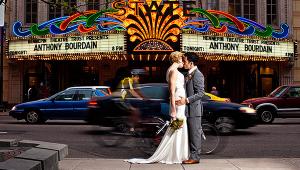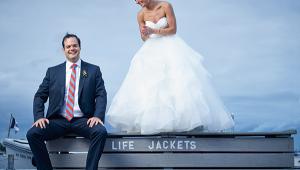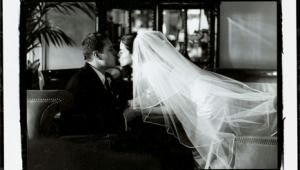The Business of Wedding Photography: Photographers Share Tips On How To Succeed In the Wedding Photography Market

Today’s wedding photography business uses many different self-promotional tools ranging from traditional bridal shows to social media advertising. No one photographer has the “right” way to run a wedding business; each photographer’s targeted wedding clientele, their individual photography style and business plan will dictate how differently they market and find clients.
One thing wedding photographers all have in common is they work very hard on planning their marketing to potential clients and then working those plans. Whether it is bridal shows, referrals, or social media, none of these photographers are sitting back waiting for the phone to ring.
I would like to thank the following photographers for their contributions to this piece: Amy Aiello, Amy Aiello Photography; Alexa Gallo, Bright Bird Photography; Andre LaCour, Andre LaCour Photography; Marc Pagani, Marc Pagani Photography; Ed Shapiro, The Hintonburg Studio of Photography. (Websites at end of article.)

Shutterbug: What marketing tactics have worked best overall for your wedding photography business?
Andre LaCour: For me the only thing that has really worked has been referrals; referrals from satisfied clients as well as other vendors. While it can’t hurt to be seen as many places as possible—bridal shows, magazines, and others—I have not found them to directly lead to sales. It also depends on your market. I think if your target is middle or lower end (and there’s nothing wrong with that) you may have greater success with other tools but the higher-end clients tend to look for referrals.
Alexa Gallo: I find that the best marketing tactic is word of mouth strengthened by social media. That includes the referrals from both clients (brides and others) as well as vendors. I’ve had to move several times over the course of my career, and when I moved to NYC, I did participate in one bridal show and I booked three weddings that day, which was amazing. But shows are a really big investment up front, which is why I prefer to count on personal relationships and referrals. Having a great website is an absolute necessity. Another important marketing tool is editorial work and being featured on prominent wedding and style blogs.
Marc Pagani: Facebook has become my number one marketing resource over the past two years. On an organic level, posting maybe 20 to 30 favorite images from any given wedding, and then tagging the bride and groom (and tagging vendors such as florist, bakery, videographer, and others) is a great way to get my images seen and my Facebook business page “liked.” For paid advertising with Facebook, I really like the fact that I can run several different ad campaigns simultaneously and that I can target very specific markets using their provided keywords and demographics. For instance, I can create an ad campaign that is geared toward my destination wedding work, utilizing one of my images from a wedding in the Caribbean, and target brides and grooms who have “liked” things on Facebook relating to “beach weddings” or “destination weddings.” I can boost specific posts on my business’s Facebook wall and I can choose exactly what my daily, weekly, or monthly budget will be, how long I want to run the “boost” or ad, and whether I want the “boost” or ad to be directed toward driving traffic to my website or to “like” my Facebook business page. I have also been an advertiser on TheKnot.com for about 13 years, and though I don’t get the same targeted exposure there as I do with Facebook, I usually book at least three to five weddings (of the 50 to 70 weddings we do per year) from The Knot. Finally, offering couples free products, like prints or a small album, for every referral I receive from them that ends up booking me is another helpful tool. Because I do not advertise in major publications, the social media, high Google ranking, other search engine rankings, and word of mouth are crucial to my business’s viability.
Ed Shapiro: Through long experience I have found that there is no single tactic or plan that will ensure a steady flow of wedding bookings. You need a number of strategies to put in place all at the same time. It’s a lot of work but it pays off. My favorite starting point is participation as an exhibitor at bridal shows. I firmly believe in direct contact with potential wedding clients and these shows and fairs present that opportunity. These shows put me in direct contact with the other exhibitors and opens up opportunities for networking with retailers, specifically those involved with the local wedding market. Some print media advertising is helpful, on an institutional level, to reinforce my show and networking activities. Believe it or not, I do not have any presence on social media at the present time as I do not feel it is compatible with my targeted upscale market. My goal is to always remain omnipresent in the wedding market by placing display material and albums with my retail contacts, including showcases at heavily trafficked malls and public places. I also speak at various service clubs and become involved in fundraising events in my community.
Amy Aiello: I’ve tried a lot of different avenues over the past eight years. I found that print and web advertising were a huge waste of my time and money, oftentimes yielding few, if any, inquiries, and absolutely no bookings (pretty embarrassing). Relationships with businesses in the wedding industry, as well as other businesses that cater to the kinds of clients I want to work with, has been my target recently. Focusing my advertising budget on my website and SEO programming has been an incredible help. My web designer is awesome for not only programming a bunch of the technical stuff, but also teaching me techniques to get more search engine hits. Metadata and keywords are not only in my blog, but also in each of the photos that I post to boost my search engine presence.

SB: Up to now, what has been your most successful sales promotion?
Andre LaCour: There hasn’t been a specific one and I don’t believe in sales or discounting. However, when I meet a couple who are getting married on a slow date I will offer incentives like an extra hour of overtime or an album upgrade.
Amy Aiello: Word of mouth hands down. Once people learn more about my news background and what I’ve done, it helps me sell what I do. Being on the team to win an Emmy Award last year for my work on the WGN news coverage of the Blackhawks winning the Stanley Cup adds to my credentials.
I also have a rewards program for my clients. For weddings specifically, anyone who refers a client to me earns a free portrait session with a care package as a thank you. The portrait side of my photography business has a point-based rewards program. Also, I have been collaborating with local business owners on how we can help one another. I’ve organized several trade-for-print shoots to provide different vendors with prints, digital files, and other sorts of promo pieces in order to help them show off their business and generate business of my own.
Marc Pagani: I am choosing to shoot one wedding for free for a lucky couple this year. Couples have to “like” my Facebook business page, then contact me through my website and write about why they feel they are “the couple” who should receive the free package. This has driven a lot of traffic to my site and my Facebook page, and I’ve booked more weddings in the past two months since I introduced the “contest” than I have in the five previous months.
Ed Shapiro: The shows are my favorite method of promotion, not only for wedding photography but for the other aspects of my studio’s specialties. Success depends on selecting the best shows, renting booth space in a good position within the venue, and producing a super impressive display. Websites are fine but there is no substitute for exhibiting beautifully framed and well-lighted masterful portraits and showing impressive well-designed albums. To me, there is nothing more effective than meeting folks face to face, handing them my literature in a handy shopping bag. We discuss their wedding date, their personal ideas and requirements. When I present seminars to other professional photographers I have a segment called “boothmanship” which specifically discusses the do’s and don’ts of creating and manning a show booth and how to walk away with many leads to follow up.
Alexa Gallo: The promotion that has gotten me the most results has been getting published on some well-respected blogs, like Style Me Pretty and Brides Magazine. I get a lot of inquiries from both of those sources. Another successful promotion that has worked really well for me is printing out promo pieces, like a cute little postcard, and placing them in local bridal boutiques.

SB: What advice do you have for a photographer looking to make a career move into this field?
Ed Shapiro: The main pitfalls are “jumping the gun” and starting out with a lack of photographic training and experience. Inept photographers who just jump in to see if they can swim will end up drowning in a devastating lawsuit or destroying their reputations. Having a fine camera and a complement of accessories does not make anyone a professional. A good photographer can make masterful imagery even with rather modest professional equipment.
Another pitfall is starting up an enterprise without a solid business plan, including market research, strategies, forecasts and projections, revenue requirements, capitalization issues, formulation of fees and rates, business and household expenses, and much more. Consultation with an accountant or professional business advisor is money well spent. Knowing the legalities of business registration, local licensing, and taxation requirements are all prerequisites as well.
Professional photography personality traits and attitudes are a prerequisite. Simply stated: one will need the patience of a saint or a god! You need to be a “people person” who can combine professionalism with kindness, empathy, helpfulness, and a great deal of resourcefulness. You need the ability to think on your feet and be ready for changes in routines or plans and occasionally cope with unexpected emotional issues. In my over 50 years in the business, I found that most weddings will go off without a hitch but the problematic situations that can occur always stand out in one’s mind.
My advice is to get the education, seek out assisting positions that can offer on-the-job training and experience. Join the local affiliate of your national professional photographers association where there are many educational opportunities being offered in the form of classes, seminars, workshops, and printed articles and publications.

Amy Aiello: The first thing is to make sure you do your research and prep work. Liability and equipment insurance are essential. Also, you should not take one photo without a signed contract. Get a good accountant and make certain you keep up with taxes!
You’ll need to build relationships. Seek out people who are social butterflies, but those who you genuinely want to befriend. Remember, nobody likes a fake person, and nobody likes to be used. Always be sure to offer something before asking for a favor. Heck, don’t ask for a favor for a while. These relationships will be the most crucial; they’ve proven to be for me.
Spending your money on the best gear is not necessary. Yes, high-end equipment will make your photos look better if you know exactly what you’re doing, but honestly limit things only to what is necessary.
Over the past year or two, I felt that my style (dramatic, “neat” lighting, use of video lights) isn’t the most marketable. In order to try to book more work, I felt I should just do what everyone else is doing. People have been liking it; a lot of it even I like. But I felt like something has been missing. I recently went to a workshop that Jerry Ghionis hosted, and realized I have been doing it wrong all this time. I have decided that I don’t want to shoot images that look like what’s popular. I want to shoot images that people will look at in years to come and not even think about when they were taken, but rather think about the emotion and memory captured within that image.
Interview your prospective clients just as much as they are interviewing you. You have the ability to decline to work with a client and should do so if you feel that you won’t work well together. If you feel they’re a good match for you to work with, talk to them as though they’re already planning on booking with you. Tell them what makes you different and show them examples. Your job is to help them envision themselves in your work.
The most important thing is to be sure not to lose yourself. Find a balance. Be sure to rest and to take care of your personal relationships. Also, keep most of your personal life private, especially the rough times, and do try to keep your social media posts upbeat and inspiring. Like brings like and people are drawn to positivity.

Andre LaCour: Never assume that a client “can’t tell the difference” and always give 100 percent. If you want to be paid better, you need to do better work and attract clients who can see and afford better. Don’t let the client be your quality control. If it’s not right, fix it. It’s either a hobby or a business. If you are going to support yourself as a photographer, you better run it like a business. I know a lot of photographers who enjoy Photoshop, so they spend hours doing it. You can outsource or hire someone to do that for $20 an hour or less. That means you can’t afford to do it. You have to do more profitable activities.
Marc Pagani: In the past, I had always felt that knowing the technical and artistic aspects of your craft were keys to being a great photographer. While I feel that is still very true, understanding that the word “business” is in the phrase “photography business” is crucial. Thinking that buying a decent camera and going to a friend’s wedding, then throwing a few images up on Facebook or Instagram will make you a photographer is a common pitfall, and it brings the overall market down. While I’ve seen some photographers achieve success by focusing solely on weddings, I’ve never identified myself solely as a wedding photographer. I also shoot adventure travel imagery (and have a book out called Fearless Photographer: Travel) as well as portraiture, editorial, live music, and corporate events.
Alexa Gallo: Don’t spend too much time comparing yourself to other people. It’s good to know what’s out there, but ultimately the key is to be true to yourself and your vision. It’s easy to get pessimistic or fearful when you’re trying something new, so it’s important to stay positive and remember what motivated you on this path to begin with. It’s an incredibly rewarding job, it’s flexible and can include traveling all over the world. I love knowing that some of the photos that I shoot will be treasured for generations to come. There’s a timelessness to it that I really love.

SB: What do you think the state of the business of wedding photography will be like five years from now?
Amy Aiello: I see a major shift toward photographers who are skilled in lighting and evoking emotion; at least, that is my hope. More and more people are realizing how special it is to work with a boutique-style photographer, and how much different the images are than a lower cost high-yield studio. I see brides and grooms seeking out quality first, then cost after. Budget will always be a determining factor, sure, but the more people see quality work, the more they’ll realize that it’s worth paying for.
I see brides and grooms seeking out photographers who want to get to know them better so that their personalities shine in the photographs. I want to be an extension of the bridal party so that I can make that happen. I don’t want to just be “the photographer.”
In five years, I’m sure there will still be quite a bit of competition, but weddings are a lot of work! I see the natural light-only photographers thinning out in numbers, and those who really know their stuff to push ahead. As a wedding photographer, you’re not just picking up a camera, clicking some images, and presenting them to your client. You’re planning along with them every step of the way, taking their images, editing their images, packaging their images, and making them feel special.
Ed Shapiro: I have been around long enough to see many traditions, trends, and buying habits come and go. Some things are classic and remain with us seemingly forever and some fads simply disappear and occasionally resurface in other forms. I think real artistry and creativity still exists and will persevere. Some of the latest advances in technology enable much more creativity and quality control than ever before. Some of the latest trends in business and craftsmanship are, frankly, disappointing to me but this is a matter of taste, subjective and business preferences on my part. I am not a big fan of strictly “shoot and burn,” “gun and run,” and “sloppy shooting” that requires massive editing and hours of time spent remedying bad photography. Personally, I teach and encourage new photographers to diversify in stylizing their work with an integration of fine portraiture and impromptu wedding photojournalism and not become a one-note photographer. I have been successful with this approach and recommend it to others.
Alexa Gallo: I think it’s going to be pretty similar to how it is now, except that photographers will be posting the images in real time and I suppose some already are! But with the speed of file sharing and editing, I would imagine everything will be happening faster and faster, from social media posts to final file delivery. Because wedding photography is such a classic genre of photography, I truly think some things will never change, people will continue to want classic printed albums and beautiful images. If anything, I would predict a higher demand in the future for weddings shot on film, Polaroid, and other alternative ways of capturing the day.

Marc Pagani: After a consistent yearly rise from 1997 to 2011, I’ve noticed a decline in the number of bookings from 2012 to 2015. While some of that may be due to changes in the economy, I also believe that a lot of it could be due to something simpler; that the standard of what makes a “good photograph” has been dropping. Facebook, Instagram, smartphones that shoot and display photos, a shift from photo-light newspaper reporting to photo-heavy online reporting of news have all contributed to people being inundated with images. Unfortunately, most of the photos we see are examples of technically bad photography. But if you take a look at the comments sections you see “beautiful photo,” “oh my god, so gorgeous.” Combined with the fact that the price of a decent digital camera has plummeted over the past decade, this means that more people are deciding that it’s just not worth it to hire a pro when Uncle Bob or “my friend who’s into photography” can do it just as well. The end result of all of this could go two different ways. In one scenario, the definition of technically sound images will change even more over time, and pro photography will become an anachronism. In another scenario, those of us who studied the craft, apprenticed with someone who knew what they were doing, and strive to create beautiful images will be fewer and farther between, and therefore more revered and will be able to demand higher fees.
Andre LaCour: When digital was starting, many film photographers thought we were going to get rich with so many people able to see the photos online and order them, and not having to produce printed proofs, and no film expense! Well, of course, the opposite has happened. The one thing that I do feel certain of is that as an image-maker, we will have to be better and more creative than ever before. With the ability to create and fix images by the novice becoming easier and easier, you will really have to stand out to make it. I would say that it’s a difficult time to choose photography as a career but there are opportunities. Many of the newer photographers I meet don’t want to take the time to learn their craft, to learn art, and to learn the history of photography. I think that they will struggle.

Web Resources
Amy Aiello: www.amyphotochicago.com, www.amyaiello.com
Alexa Gallo: www.brightbirdphotography.com, www.facebook.com/BrightBird
Andre LaCour: www.andrelacour.com
Marc Pagani: www.paganiphoto.com, www.marcpagani.com, www.facebook.com/paganiphoto
Ed Shapiro: http://ca.linkedin.com/pub/ed-shapiro/2b/846/264/
- Log in or register to post comments
